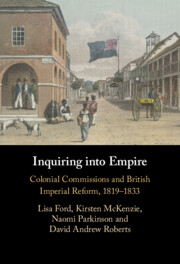Book contents
- Inquiring into Empire
- Inquiring into Empire
- Copyright page
- Contents
- Figures
- Maps
- Acknowledgements
- 1 Introduction
- Part I Constructive Conservatism in Empire
- 2 The State of Things
- 3 Reordering New South Wales
- 4 Remaking Caribbean Courts
- 5 Defending the Crown
- Part II The Problem of Unfreedom
- Part III The End of the Affair
- A Note on Sources
- Bibliography
- Index
3 - Reordering New South Wales
from Part I - Constructive Conservatism in Empire
Published online by Cambridge University Press: 18 March 2025
- Inquiring into Empire
- Inquiring into Empire
- Copyright page
- Contents
- Figures
- Maps
- Acknowledgements
- 1 Introduction
- Part I Constructive Conservatism in Empire
- 2 The State of Things
- 3 Reordering New South Wales
- 4 Remaking Caribbean Courts
- 5 Defending the Crown
- Part II The Problem of Unfreedom
- Part III The End of the Affair
- A Note on Sources
- Bibliography
- Index
Summary
The Bigge Inquiry into New South Wales from 1819 demonstrates how inquiry in some respects mirrored Britain’s own counterrevolutionary project of restoring social and political hierarchies by sponsoring elites and limiting convict opportunity. But Bigge also modelled the power of commissions to bend their reports to suit local claims. In the course of his inquiries, Bigge was convinced by local elites to recommend the opening of frontiers to free capitalist farmers and pastoralists. He also proposed that elites should have a strong say in local government but was less convinced by calls to introduce an independent judiciary. The evidence he gathered prompted Earl Bathurst’s Colonial Office to compromise by limiting gubernatorial autocracy and expanding judicial authority. The resultant New South Wales Act set the parameters for conservative constitutional reform, which, by 1825, Bathurst planned to roll out in every crown colony in the empire.
Keywords
- Type
- Chapter
- Information
- Inquiring into EmpireColonial Commissions and British Imperial Reform, 1819–1833, pp. 54 - 80Publisher: Cambridge University PressPrint publication year: 2025

